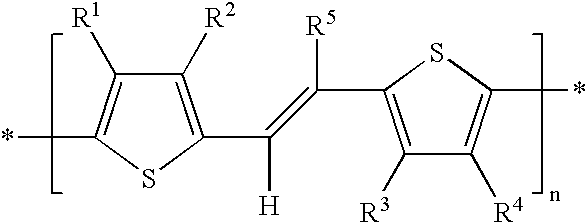Mono-, oligo- and poly-difluorovinyl-(hetero)arylenes, their synthesis and their use as charge transport materials
a technology of difluorovinyl(hetero)arylene and oligo-arylene, which is applied in the direction of organic chemistry, sulfur dyes, and conductors, can solve the problems of reduced device performance, low ionisation potential of poly(3-alkylthiophenes), and high processing cos
- Summary
- Abstract
- Description
- Claims
- Application Information
AI Technical Summary
Problems solved by technology
Method used
Image
Examples
example 1
[0208] 2-(2'-chloro-1,2-difluorovinyl)-3-hexylthiophene (V.1, R.sup.1=H, R.sup.2=hexyl)
[0209] In a dry 3-necked flask under nitrogen n-BuLi (1.6M in hexanes, 15 ml) was diluted wit dry tetrahydrofuran (THF) (30 ml) and cooled to -78 C. "-Bromo-3-hexylthiophene (5.0 g, 0.02 mol) was added dropwise over 15 minutes (min). The reaction was stirred at -78 C. for 2 hours (h). In a separate flask chlorotrifluoroethylene (15 ml, excess) was liquified and stirred at -42 C. The solution of thiophene was added via a cannula over 30 min, and the reaction stirred at -42 C. for 4 h. The reaction was warmed to room temperature (RT) and stirred for a further 14 h. The reaction was quenched with sat, ammonium chloride and extracted with THF (3.times.50 ml). The combined organics were washed with brine, dried (Na.sub.2SO.sub.4), filtered and concentrated under reduced pressure to afford a yellow oil (4.70 g). This was further purified by filtration through silica (eluent: petrol) to afford 2-(2'-chlo...
example 2
[0210] 5-(2'-chloro-1,2-difluorovinyl)-3-hexylthiophene (V.1, R.sup.1=hexyl, R.sup.2=H)
[0211] A solution of 3-hexylthiophene (30 g, 0179 mol) in anhydrous petrol (40-60 C., 100 ml) was cooled to -10 C. and diisopropylamine (freshly distilled, 18.1 g, 0179 mol) and tetramethylethylenediamine (TMEDA) (33 g, 028 mol) were added. N-BuLi (1.6M in hexanes, 113 ml, 0.18 mol) was added dropwise over 30 min at -10 C. The solution was warmed to 0 C. over 1 h, and then added via cannula to a solution of chlorotrifluorethylene at -78 C. The reaction was warmed to RT over 2 h and stirred for a further 16 h. The reaction was quenched with sat, ammonium chloride and extracted with THF (3.times.50 ml). The combined organics were washed with brine, dried (Na.sub.2SO.sub.4), filtered and concentrated under reduced pressure to afford a yellow oil (47 g). High vacuum distillation through a packed column with a reflux ratio head (0.1 mbar, 70-71 C.) afforded 13.0 g of product. Purity (HPLC) >99%. MS (EI...
example 3
[0212] Poly(difluorovinyl)-3-hexylthiophene.
[0213] To a solution of freshly distilled diisopropylamine (0.23 g, 3.11 mmol) in dry THF under nitrogen at 0 C. was added n-BuLi (1.56M in hexane, 1.9 ml, 9.98 mmol). The solution was stirred for 10 min at 0 C. and then cooled to -78 C. 2-(2'-Chloro-1,2-difluorovinyl)-3-hexylthiophen-e (0.75 g, 2.83 mmol) was added dropwise and the reaction stirred at -78 C. for 4 h. A solution of ZnCl.sub.2 in diethyl ether (1M, 3.1 ml, 3.1 mmol) was added and the reaction stirred for a further 1 h. In a separate schlenk flask a solution of 1,4-bis(diphenylphosphino)butane (55.6 mg, 0.13 mmol) and tris(benzylideneacetone)dipalladium (59.7 mg, 0.065 mmol) in anhydrous NMP (5 ml) was prepared. The organozinc reagent was transferred into the schlenk flask by cannula and the mixture heated to 100 C. for 18 h. The reaction was cooled and poured into methanol and the resulting precipitate filtered. This was washed with methanol to afford poly(difluorovinyl)-3-...
PUM
| Property | Measurement | Unit |
|---|---|---|
| Electrical conductor | aaaaa | aaaaa |
| Transport properties | aaaaa | aaaaa |
Abstract
Description
Claims
Application Information
 Login to View More
Login to View More - R&D
- Intellectual Property
- Life Sciences
- Materials
- Tech Scout
- Unparalleled Data Quality
- Higher Quality Content
- 60% Fewer Hallucinations
Browse by: Latest US Patents, China's latest patents, Technical Efficacy Thesaurus, Application Domain, Technology Topic, Popular Technical Reports.
© 2025 PatSnap. All rights reserved.Legal|Privacy policy|Modern Slavery Act Transparency Statement|Sitemap|About US| Contact US: help@patsnap.com



